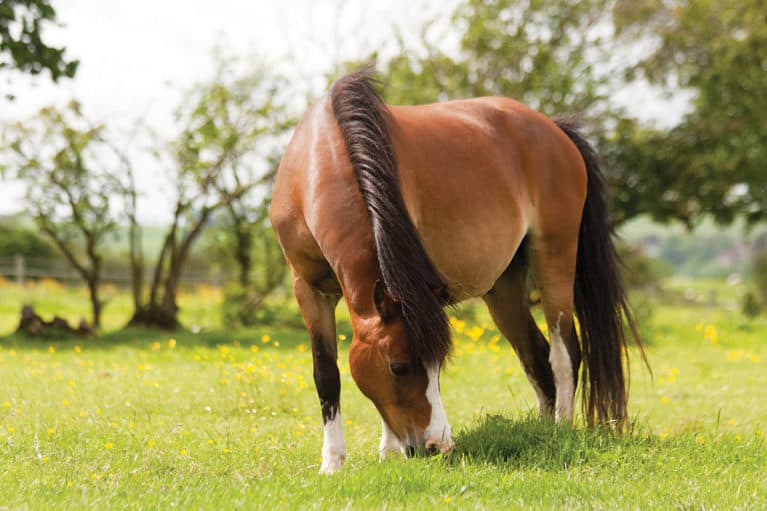Being overweight has serious health implications for your horse. World Horse Welfare’s Sam Chubbock explains how you can help

Although you know your horse shouldn’t carry excess weight, it can be a real challenge to recognise what healthy condition looks like. It’s also becoming increasingly normal to see horses carrying more weight than they should. An overweight horse may not only have a poor quality of life, but is also at a higher risk of a number of health problems.
Excess weight is one of the most common triggers of laminitis and there’s also a clear link between it and equine metabolic syndrome (EMS), which is another key cause of laminitis. Carrying excess weight also places extra strain on your horse’s heart and lungs, as well as added pressure on his limbs and joints. He’ll be less able to perform well in his ridden work and, in addition to carrying his own extra weight, he has to carry you and your tack, too.
Working out weight
It’s important to understand what you’re trying to assess – knowing your horse’s actual weight is useful, but it can be hard to tell if this is appropriate for him. Although guideline weight to height ranges exist, there’s so much variety within horse body types that these are of limited value.
The best way to find out if your horse is carrying the right amount of body fat is to learn how to fat score, also known as body condition scoring. There are two main fat-scoring systems – the 0–5 system or the 1–9 system – and both focus on getting hands-on and feeling for fat cover rather than just looking at your horse. If you have limited experience of fat scoring, the 0–5 system is easier to apply and you can find a handy chart at bit.ly/RightWeight
A weightape provides a good tool for monitoring weight and identifying changes, but remember this doesn’t reflect condition. The most accurate weightapes have a horse and a pony side so you can choose the correct one according to your horse’s height. A combination of fat scoring and using a weightape is ideal for ongoing weight management.
Slimming success
When considering weight loss options, a good place to start is looking at what you’re currently doing…
- how much feed does your horse have each day, including grass and hay?
- for how many hours is he turned out?
- how much exercise does he do?
- does he wear a rug?
Weight loss isn’t just about feeding less, so any plan needs to cover all aspects of your horse’s lifestyle. Looking at the current situation will help you see where a few small changes can make a big difference. You don’t necessarily have to devote hours each week to increasing his exercise.
Feeding solutions
Consider whether you really need to give your horse hard feed and, if so, whether it’s appropriate for his workload. If your yard has a feeding routine or you like to reward him after work, then a good alternative can be to feed him a low-calorie, super-concentrated pelleted balancer. You can offer this as a treat or in a bucket so he won’t feel he’s missing out, without adding unwanted calories to his diet. If you need a carrier feed for a powdered supplement, choose a low-calorie one and measure it accurately so you know you’re feeding the right amount.
Weigh your forage using a hanging scale and soak hay for several hours to reduce its calorie content – get advice from a nutritionist about the best way to approach this for maximum benefit. You can add bulk to a haynet without extra calories by mixing it with good-quality oat or barley straw, but take advice from a nutritionist or your vet as this isn’t suitable for all horses, particularly those with poor teeth.
Using small-holed haynets will help make forage last longer and you can even put one haynet inside another so it’s more of a challenge for your horse to eat. To help relieve boredom while on a limited ration, try dividing the forage between two or three nets spread around your horse’s field or stable.
Turnout
Limiting the time your horse spends in the field isn’t always the best way to help him lose weight, because sometimes horses with limited grazing time eat at a faster rate and, therefore, consume more than they would if they stayed out for a full day. A better option is to reduce the area of grass your horse has access to, rather than the time he’s turned out.
If you have the facilities, a track system is a great way to reduce grazing and get your horse moving around more. These can range from a single track around the outside of the field – the centre can be a good place for other horses who may need a little more grazing – or a more complicated maze if you’re feeling creative. Place the water trough at one end of the track and the gateway at the other, and if additional low-calorie forage is needed, you can leave piles of it at different points around the track so your horse has to keep moving in order to find his food and drink.
There are lots more ways to tackle your horse’s weight in the May issue of Horse&Rider, on sale 6 April 2017.















